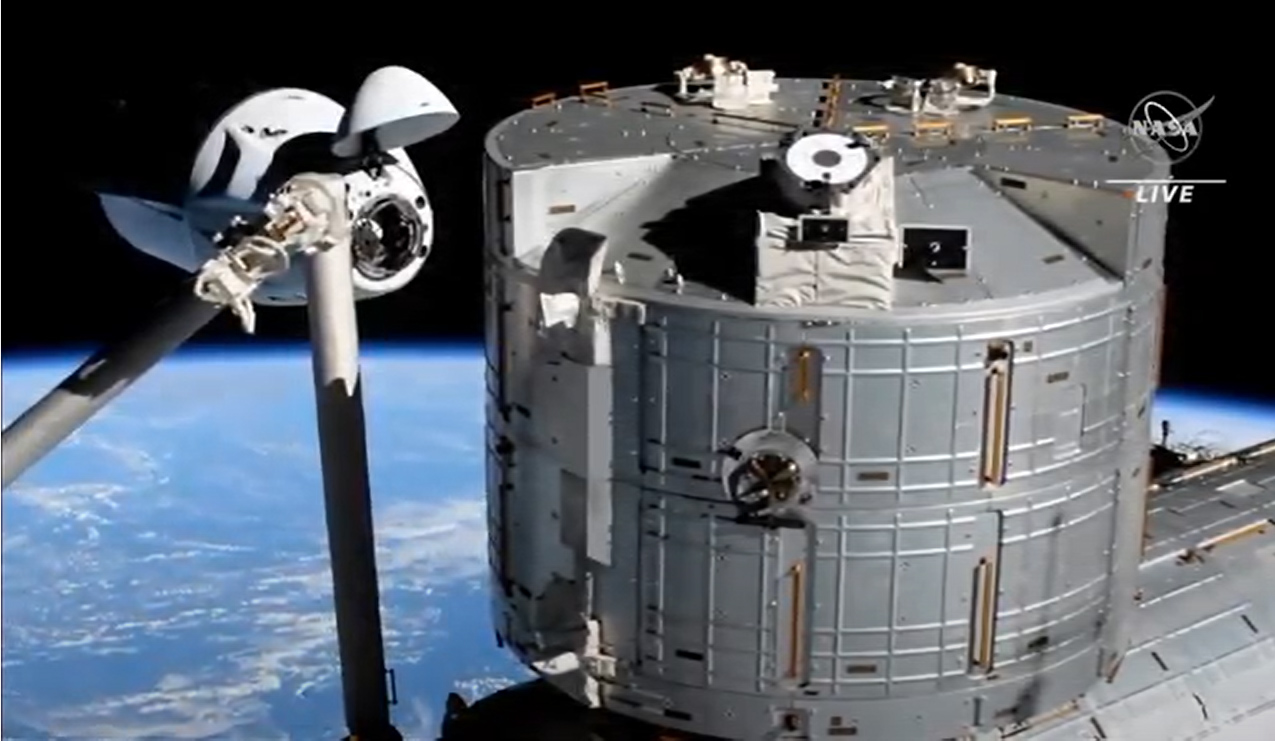A piece of space junk zipped by SpaceX's Dragon capsule on its way to the space station
The astronauts of SpaceX's Crew-2 mission for NASA had a brief moment of suspense after their spectacular launch on Friday (April 23) when a piece of space debris passed unexpectedly close by their Crew Dragon capsule.
The space junk encounter, called a conjunction, occurred at 1:43 p.m. EDT (1743 GMT) as the four Crew-2 astronauts were preparing to sleep after a long day. Their Crew Dragon Endeavour docked at the space station early Saturday.
"For awareness, we have identified a late breaking possible conjunction with a fairly close miss distance to Dragon," SpaceX's Sarah Gilles told the astronauts about 20 minutes before the conjunction on Friday. "As such, we do need you to immediately proceed with suit donning and securing yourselves in seats."
Gilles told the astronauts to get back into their spacesuits and seats as safety precaution in case of an impact. You can watch the exchange here, courtesy of Raw Science.
Photos: SpaceX's Crew-2 launch lights up the sky with a spectacular show
Live updates: SpaceX's Crew-2 astronaut mission for NASA
"Copy Sarah, you want us in the suit for a possible close call,"Crew-2 astronaut Thomas Pesquet of the European Space Agency radioed back.
As the time of the space debris conjunction approached, Gilles radioed an update to the Crew-2 astronauts to say the debris appeared to be passing Crew Dragon at a farther distance than initially expected. By 1:44 p.m. EDT, Gilles radioed the all-clear to say that the debris had passed by without incident.
Get the Space.com Newsletter
Breaking space news, the latest updates on rocket launches, skywatching events and more!
"Dragon, SpaceX, we have passed TCA with no impact," Gilles said of the debris. The distance and composition of the debris was not immediately clear.
After the conjunction, the Crew-2 astronauts — Shane Kimbrough and Megan McArthur of NASA, Pesquet of the European Space Agency and Akihiko Hoshide of Japan — got out of their suits and continued with their evening. They arrived at the station on Saturday without any more surprises.
Related: 7 wild ways to clean up space junk

Such close encounters with space junk have occurred several times over the years, with the International Space Station and some NASA shuttles occasionally moving to dodge debris as a safety measure. The space station is huge, about the size of a football field, but SpaceX's Crew Dragon — a space capsule — is relatively small at just under 27 feet long (8 meters).
Last September, a potential space debris threat forced the space station's then-three-person crew to take shelter inside the station's Russian segment to be closer to their Soyuz spacecraft in case of an impact.
Space debris is a growing concern for astronauts and satellites as companies launch more and more missions into space, including megaconstellations like SpaceX's Starlink satellite internet project, which now numbers more than 1,400 satellites.
This week, the European Space Agency held the 8th European Conference on Space Debris to discuss the problem of space junk. There is an estimated 128 million objects larger than a millimeter in orbit today, according to an ESA overview.
Email Tariq Malik at tmalik@space.com or follow him @tariqjmalik. Follow us @Spacedotcom, Facebook and Instagram.
Join our Space Forums to keep talking space on the latest missions, night sky and more! And if you have a news tip, correction or comment, let us know at: community@space.com.

Tariq is the Editor-in-Chief of Space.com and joined the team in 2001, first as an intern and staff writer, and later as an editor. He covers human spaceflight, exploration and space science, as well as skywatching and entertainment. He became Space.com's Managing Editor in 2009 and Editor-in-Chief in 2019. Before joining Space.com, Tariq was a staff reporter for The Los Angeles Times covering education and city beats in La Habra, Fullerton and Huntington Beach. In October 2022, Tariq received the Harry Kolcum Award for excellence in space reporting from the National Space Club Florida Committee. He is also an Eagle Scout (yes, he has the Space Exploration merit badge) and went to Space Camp four times as a kid and a fifth time as an adult. He has journalism degrees from the University of Southern California and New York University. You can find Tariq at Space.com and as the co-host to the This Week In Space podcast with space historian Rod Pyle on the TWiT network. To see his latest project, you can follow Tariq on Twitter @tariqjmalik.









